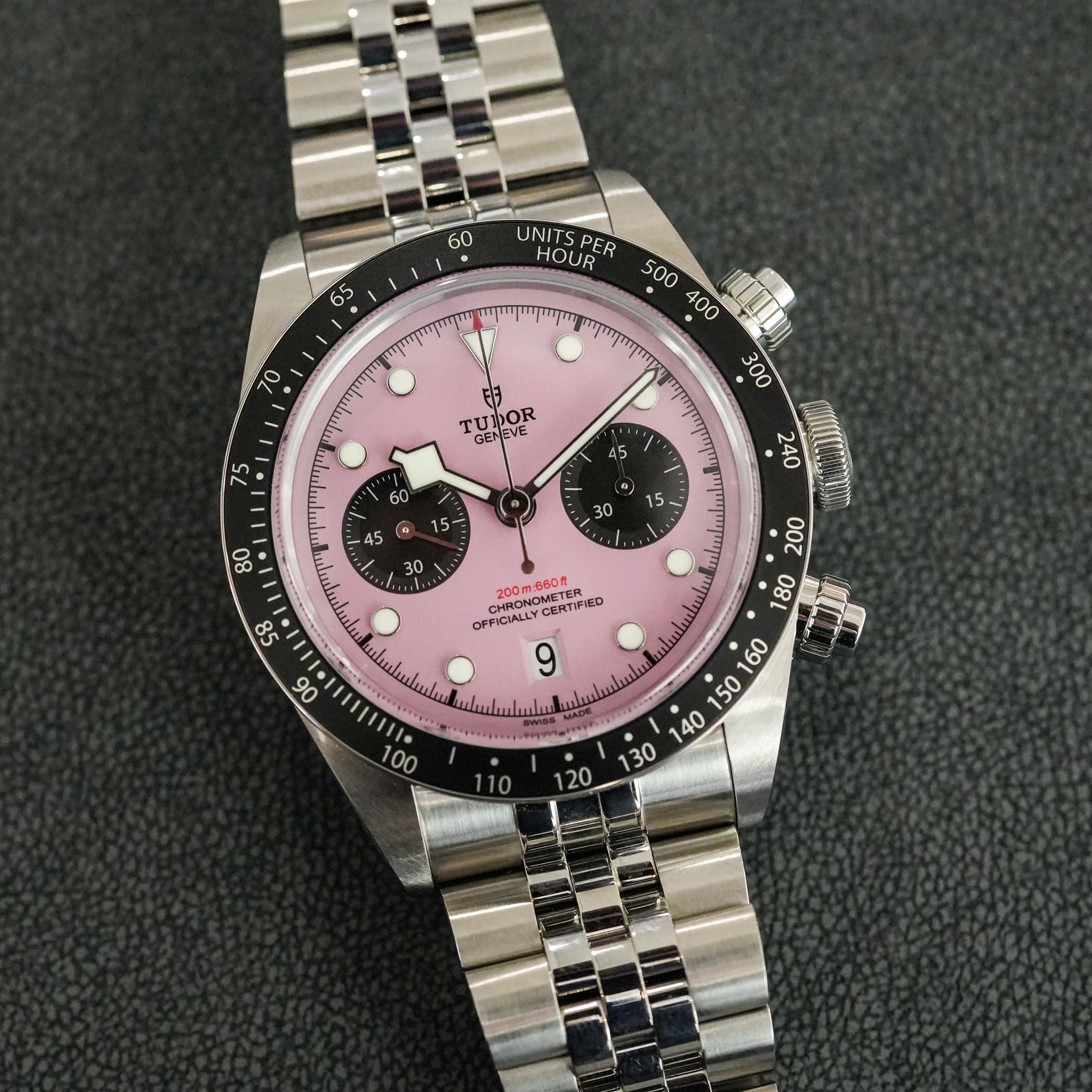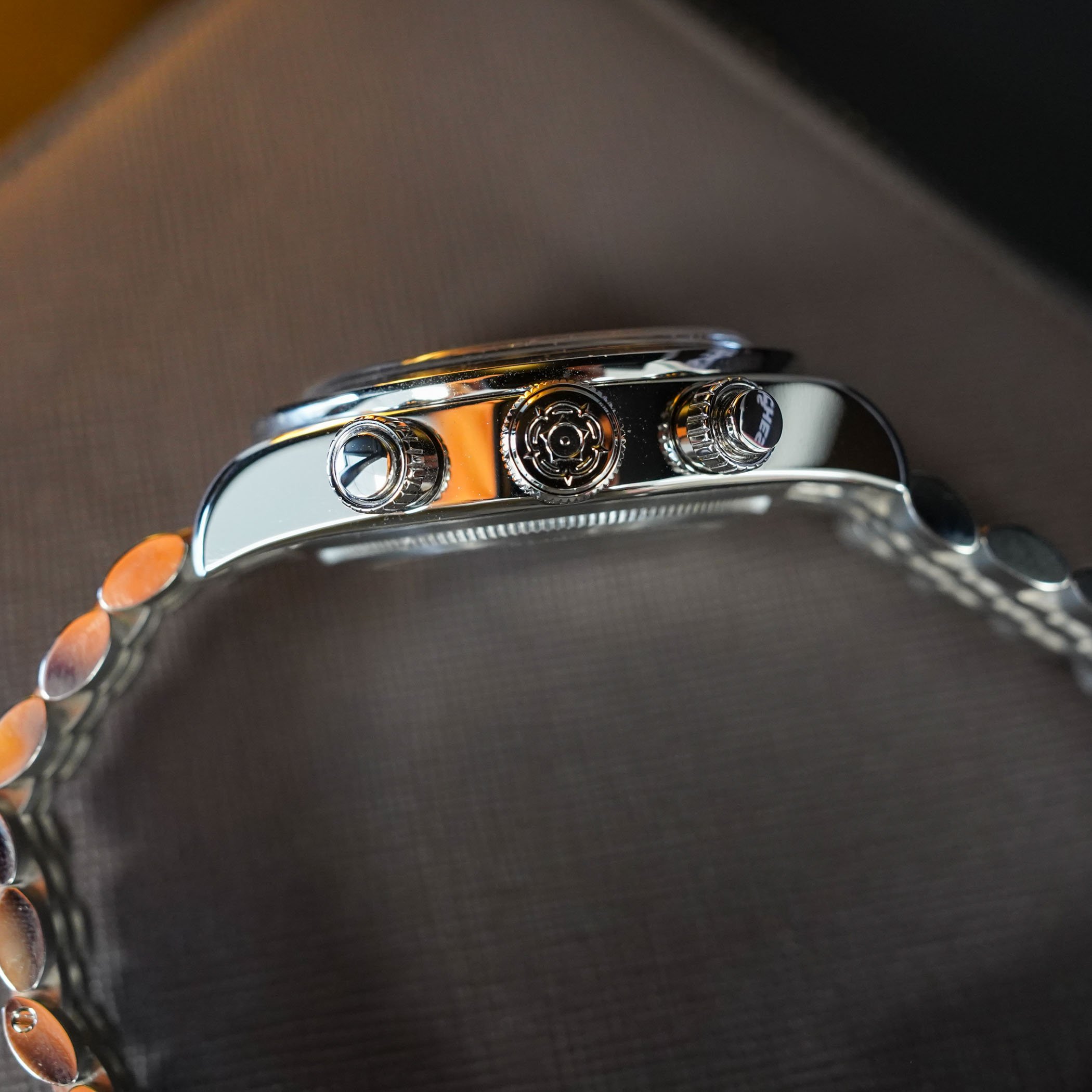The Tudor Black Bay Chrono Blue Boutique Edition
Sure, it's just a different colour, but this boutique-only Black Bay Chrono Blue has a strong appeal.

When it was first presented in 2017, the Black Bay Chrono generated mixed emotions. The good ones came from the overall performance and fairly reasonable price (considering the whole package), as well as the unexpected industrial alliance with Breitling. Others pointed out the rather uninspired design of the inaugural edition as well as the strange mix between racing elements and dive watch features. But we’re now seven years down the line, and the Tudor Black Bay Chrono isn’t what it was back then. It has evolved gradually to become a better-looking, more appealing watch. It even made headlines in a surprisingly cool Pink edition. Is the latest model in the collection, the Black Bay Chrono Blue, elevating this watch again? Let’s find out.
Context
Whether in its past or present, Tudor is no stranger to the chronograph function. Yet, contrary to mother brand Rolex and its competitors, Tudor entered the race much later, as its first chronograph only appeared in 1970, with the Osyterdate Homeplate 70xx series. These early mechanical manually wound models were followed by the Montecarlo 71xx series. These two vintage models would become the base for modern re-editions, the Tudor Heritage Chrono and the Tudor Heritage Chrono Blue. There were more chronographs down the line, such as the Prince Oysterdate models, first presented in 1976 as the first automatic chronographs of the brand, which gave us multiple 1970s and 1980s Big Block Prince Chronograph watches – something we expect to come back sooner or later, due to this teaser… In more recent years, we’ve also seen other collections with a chronograph, such as the FastRider Chrono (now discontinued) or the recent Pelagos FXD Chrono.

However, in Tudor’s modern history, the most important chronograph has to be the Black Bay Chrono. When it was first presented in 2017, the watch made some noise due to multiple factors. An important element was the movement, which was not sourced from ETA but from Breitling, as a result of an industrial alliance where Tudor would get B01 movements from Breilting and in exchange Kenissi (partially owned by Tudor/Rolex) would deliver automatic movements to Breitling – a clever move in an industry usually shy in talking about such ventures.

Then, despite some inherent qualities, solid specifications and a relatively reasonable price considering what Tudor delivered, the Black Bay Chrono also provoked some negative comments at first. Mostly, this had to do with the slightly insipid look of the watch (the steel bezel and full black dial didn’t help) and the positioning. The watch was part of the Black Bay family, a range of dive watches, and as such retained some of the collection’s features – strong water-resistance, overall shape of the case and Snowflake handset. At the same time, it added some traditional elements of racing chronographs, such as the tachymeter scale. It was a bit confusing, resulting in a watch lacking clarity and with comments regarding the legibility of the sub-dials due to the hour hand (well, that one comment could be said about many chronographs…)
Yet, Tudor listened to the comments and came up with upgrades and evolutions over the life of the Black Bay Chrono. The most important update came in 2021, with the launch of the Black Bay Chrono 79360N with Panda and Reversed Panda dials. While on the technical side not much had changed, the watch gained in visual appeal thanks to a contrasting aluminium bezel insert and new dials with colour-differentiated sub-counters. Tudor also made it marginally thinner. Minimal changes that made a world of difference.
The Tudor Black Bay Chrono Blue
The Black Bay Chrono Blue is not revolutionising the concept. It is, after all, only a colour evolution of the Black Bay Chrono Panda models of 2021, with its strengths and flaws. Yet, as I’ve said on multiple occasions in the past, a simple change of colour and dial texture can drastically change a watch. Even more so in the present case, where we’re treated to a different bracelet.
As you’d expect from this watch, the Black Bay Chrono Blue retains the case design and specifications of the previous editions with black or white dials. As such, it is still a slightly bulky watch measuring 41mm in diameter, 14.2mm in height and just under 50mm in length. Photographed here on Robin’s 18.5cm wrist, the watch feels nicely proportioned and sits well on him, at least considering we’re looking at a modern, sporty chronograph with diving credentials. If you take into account that the watch has a modern automatic chronograph movement and a 200m water-resistance, the dimensions are actually on par if not below the competition’s average… To put things into perspective, an Omega Seamaster Diver 300M Chronograph, even though it’s a bit more robust, it’s also 3mm larger and 3mm thicker. An Oris Divers Sixty-Five Chronograph, with a 100m rating, is 1.2mm thicker too. A Carrera Glassbox? Hardly thinner at 13.9mm.
Far from me congratulating Tudor for the Black Bay Chrono, but in its competitive environment and considering its specifications, it is not that bad after all. That being said, the Black Bay Chrono Blue, like its siblings, is a watch that will require a man with a certain stature. For instance, with my 16.5cm wrist, I think this watch is still manageable but not the best looking. There’s something with this Blue edition that must noted, though, and that has to do with the bracelet and its first links; it is more flexible than an Oyster bracelet and makes it shorter on the wrist.
For the rest, this Black Bay Chrono Blue is everything you’d expect from this collection. The case, neatly executed as always, combines brushed top surfaces with polished lateral bevels and flanks. The caseback, in solid steel (good for a personalised engraving), sits flush with the case. Tudor could give it a more domed profile and reduce the thickness of the flanks to slim down this watch visually. The right side is home to a rose engraved, relatively flat but large screw-down crown and screwed pushers… Good for the water-resistance, and less for the instant use of the chronograph function (Daytona owners know about that). But it’s all very neat, very solid.
What has changed, then? Well, obviously, the colour, as the name of the watch indicates. Blue is the theme here, a colour fairly familiar to Tudor. It concerns two main elements of the watch. First the anodized aluminium bezel, which has a matte blue finish and a silver-toned tachymeter scale. Then, the same dark (but not too dark) tone of blue was applied to the dial, combined with silvery-white sub-counters at 3 and 9 o’clock, rhodium-plated hands and applied hour markers, white tracks and printings, a white date disc and two discreet touches of red on the tip of the central seconds hand and the depth rating.
But what changes most compared to most previous editions of the Tudor Black Bay Chrono is the finishing of the dial, which now has a sunray-brushed texture. Add this decoration to the domed profile of the dial, and you’ll end up with a watch that is much more lively under natural light than all of its steel siblings – both panda models and the Pink edition have matte dials. The Black Bay Chrono Blue is more dynamic, more playful, and somehow a bit more refined thanks to this finish. Also, the blue tone chosen by Tudor is fairly pleasant. It’s not overly saturated and not too dark.
Inside the robust case of the Black Bay Chrono Blue is the calibre MT5813, which is still based on the Breitling B01 architecture. We’re talking about an integrated automatic movement with a modern construction and a fine chronograph mechanism – a combination of a column wheel and a vertical clutch. As a Tudor should be, it is chronometer-certified by COSC and features a variable inertia balance and a silicon balance spring. It’s also generous on power, with 70 hours of energy when fully wound. But my guess is that we won’t see this movement for long, as Kenissi is working on a replacement, which was teased in the Tudor Prince Chronograph One, a unique piece featuring the calibre MT59XX prototype – and it can’t be just a one-off, knowing the complexity of developing a chronograph movement. But for now, the Black Bay Chrono Blue retains its Breitling-based movement (nothing wrong with it…)
The final specificity of this Blue chrono is the bracelet. Contrary to the panda models, but like the Pink edition or the recently revised versions of the Black Bay, it is worn on a 5-link Jubilee-style bracelet – no other option available, no additional strap included. This Jubilee bracelet, in my opinion, benefits both the looks and the comfort. It adds a cool retro touch to the watch, and mostly, it is far more flexible and soft than the Oyster bracelet. And it comes with the T-Fit micro-adjustment folding clasp, allowing for an instant adjustment of the total length of the bracelet along a window of 8mm on 5 steps.
Availability & Price
Just like the Black Bay 58 Bronze before, this Tudor Black Bay Chrono Blue is only available from the brand’s official boutiques (see here). It is not limited in number but might require you to travel a bit to get one. As for the price, it retails for EUR 5,720, CHF 5,300 or USD 5,675. I won’t call it accessible, but considering what you get in return, it feels justified and in line with its competitive environment – for example, the most accessible Breitling with the same base movement, the Top Time B01, starts at EUR 7,800.
For more details, please visit TudorWatch.com.


















